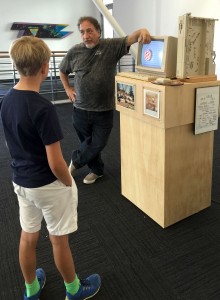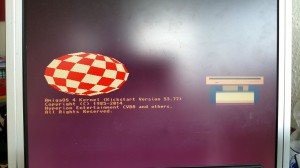I can’t believe it’s already March 2016! Just where does the time go these days?

As I write this blog I’m preparing for a whirlwind trip to California to attend Dave Needle’s memorial service and big farewell party. No doubt it will be a bittersweet event but a chance to celebrate Dave’s life and work with his close family, friends and extended Amiga family. Thanks to the advantage of living in the future, I am leaving New Zealand on Friday evening and arrive in San Francisco on Friday morning. I’m only staying for a couple of days as I need to be back in Wellington for the middle of next week. Many thanks to RJ Mical for offering me a place to sleep for my short stay in California. Strangely, it seems like only yesterday I was chatting with Dave Needle at the Amiga30th Anniversary in Mountain View, California, listening him tell fascinating stories about the early days of the Amiga.
All Amigans will know about Dave’s valuable contribution to the Amiga’s birth. Most are probably aware of his work with RJ Mical on the Atari Lynx, the first hand-held games console with a colour LCD display and the advanced but ultimately unsuccessful 3DO game console. However, I don’t think many will know, including me until I did some research, that after Dave left Commodore he worked for Apple on a new 5 MIPS RISC low-cost prototype processor. When he was finished he took his new processor design to the silicon manufacturer who made Apple’s chips.

On seeing Dave’s design they pointed that it was very similar to another processor from a British company which was at a much later stage of development. After Apple signed the required NDA, Dave got access to the new CPU chip layout and discovered the design was not only very similar to his but it was much further advanced and actually better. So he ditched plans for his CPU design and used the alternative processor for the new low cost computer. Within a short period of time his tiny but powerful little machine based on the new RISC processor was running Apple II software with full colour support. Ultimately, Apple management scrapped plans for the new computer and voted in favour of the Apple IIgs. The new processor that Dave used was none other than the Arm chip from Acorn Computers which has since gone on to dominate the world of smartphones. If you want to find out a little more about Dave’s life and achievements I’ve just finished writing a short article for the next edition of Amiga Future magazine. R.I.P. Dave, you will be missed.
Amiga-tinted glasses

I was driving along the road the other day when I notice what looked like an Amiga ship docked at the oil terminal in Seaview, near Wellington. I just had to stop and take a photo but what looked like “Amiga” turned out to be “d’Amico”. My wife thinks I need to seek medical help! 😉
I-Spy

I made a quick trip to the the NE of England in January on personal business. When passing back through London on my way home to New Zealand I took the opportunity of meeting up with Matthew Leaman and two of our active developers, Andy Broad and Darren Stevens.


We took in the the traditional tourist sights of Buckingham Palace, Big Ben, London Bridge, the Houses of Parliament and planned and schemed outside of MI6 and quickly scarpered after taking the obligatory selfie. (Have you seen the latest James Bond film?)
After walking for over 10 miles (>16 km) according to my smartphone fitness app we then retired to a traditional London pub and later a nice little Italian restaurant in Pimlico called 2 Amici (looks vaguely like Amiga to me) which I used to visit when I lived in London. The company, beer and food were all good. Although Matthew was a little surprised to find he had been made a saint. I know he is good, but he’s not that good!
From little acorns
I received a pleasant surprise in my email inbox this morning from AmigaOS Kernel developer Thomas Frieden.

All the email message said was, “Hi, I’ll let the image speak for itself.” Attached to the email was a photo of a vaguely familiar image of a Boing Ball, Hyperion copyright notice and an “insert floppy disk” graphic. I wonder what it could all mean? On second thoughts I think it means my Tabor board will be mighty pleased and before anyone says it, yes the Hyperion copyright notice needs updating. One step at a time. 😉 What was my simple two word email reply to Thomas, “Thank you”.
Can one billion Indian consumers be wrong?
Ringing Bells, a new and previously unheard of Indian electronics company, has just announced its Freedom 251 phone which is set to become the world’s cheapest smartphone. If you are wondering about the strange numbering system, 251 refers to the actual sales price of the phone which is set at 251 rupees and is equivalent to an eye-watering low price of $3.67. I suppose if it was sold US$ it would be called the Freedom 3.67 or even 3.295 Euros in Europe 😉

The phone, which runs Android Lollipop 5.1, is powered by a 1.3 GhZ quad-core SoC processor, sports a 4″ (10.2 cm) qHD IPS screen and has 1 GB RAM together with 8GB internal storage which can be expanded to 32 GB. It also has 0.3 mega pixel front camera and 3.2 mega pixel rear camera and comes with a 1450 mAh battery. If you are the type of person who queues up for days to buy the latest Apple iPhone product, the Freedom 251 is not for you. India is the world’s second largest mobile market with over a billion mobile phone users and the Freedom 251 is targeted at the mass-market of low cost handsets. Bizarrely, as of 2016, India has recorded more selfie-related deaths than any other country. With over one billion mobile phone users I suppose it’s not surprising.
Apparently the Freedom 251 was developed with support from the Indian government as part of Prime Minister Narendra Modi’s flagship Make in India scheme and according to the publicity has the potential to realise the ‘Digital India’ vision. The phone was officially launched by Indian Defense Minister Manohar Parrikar at an event in New Dehli and is already causing controversy in India with industry experts claiming that “even using the cheapest components possible, a phone with the Freedom 251’s specifications should cost at least Rs 1,000 or more to manufacture and that doesn’t include advertising and distribution” costs. Also, the Ringing Bells company itself is only a few months old. Hopefully this is not some elaborate scam and the Freedom 251 doesn’t turn into the Freedom 451. (I’ll let you work that one out! ;-)) Personally, I think Freedom 247 would have been a better name and allow for future price variations.
There was a booking page to pre-order your Freedom 251 but this is presumably reserved for India resident consumers only? Anyway if you live in India and wanted to take the risk, it’s already too late as pre-order for the phone only ran from 6:00 AM on 18th Feb until at 8:00 PM on 21st Feb 2016. Delivery is anticipated 30th June 2016. I’m sure this story will continue to run and develop.
….finally
That’s all for now, my bags are packed and A.L.I.C.E. is in my hand luggage. Next stop California.
(Dave Needle photograph credit: Bart Grantham)